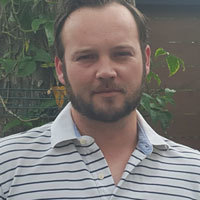Editor’s note: After doing such a great job with his last piece, I brought back Andrew Egan for another post. Check it out.
Today in Tedium: Governments, or more specifically, their tourism boards are usually enthusiastic to promote any noteworthy site or event possible. This has lead to more than a few missteps, of course. Like the recent "Syria: Always Beautiful" campaign touting the country’s beaches. Come for the Mediterranean scenery, please ignore the raging civil war. This eagerness to encourage tourism makes certain decisions particularly interesting. Denying or restricting access, or even failing to promote something significant, is lost revenue. In some instances, the reasons for doing so are practical, as with Chernobyl or any number of active government buildings. With others, it’s a matter of taste and dignity. I doubt the German Tourism Board will launch a million-euro campaign touting tours of the country’s concentration camps. Today’s Tedium heads to Germany to look at why we get to see some things, but not others. — Andrew @ Tedium
1.5M
The number of people that visited the Auschwitz concentration camp in 2014. After some research (along with a fair amount of estimation) and back-of-the-envelope math, concentration camps add some $100 million annually to the economies of Germany and Poland.
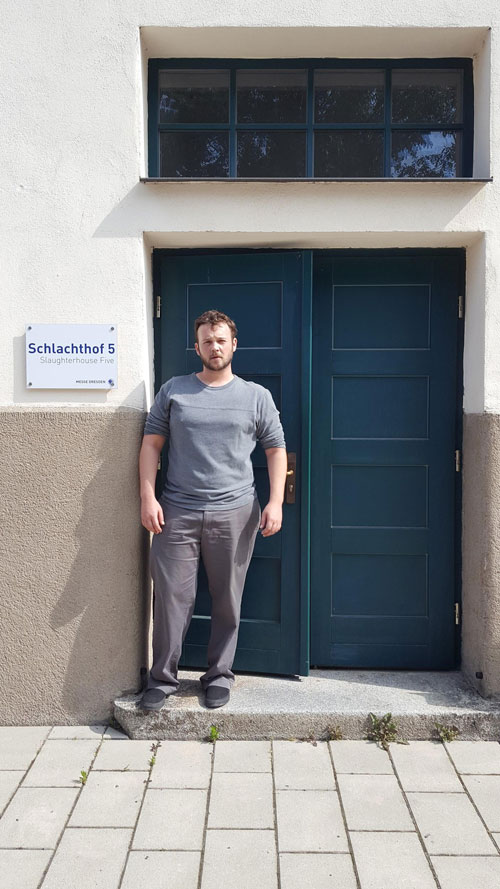
Me standing at the entrance of Slaughterhouse-Five. I never know what to do with my hands in pictures. (Danilo Hommel)
How is access to historically significant sites determined?
World War II tourism is a big money-maker. While admission to Auschwitz is free, guided tours begin at 25 euros per person. Keeping in mind other notable sites, such as the Normandy beaches, Buchenwald, or Dunkirk, and the money flowing from tourists is substantial.
The exact amount spent on World War II tourism is difficult to pin down, if it has ever been accurately assessed. Google doesn’t exactly return a bevy of useful results for the phrase "World War II tourism." It’s easy to understand why beneficiary countries would avoid putting an exact figure to the industry. But you could also think that involved tourism boards would be eager to highlight positive stories from the era. Which makes the relative obscurity and inaccessibility of Slaughterhouse-Five that much more curious.
Made famous by American writer Kurt Vonnegut, Slaughterhouse-Five is an actual place in Dresden and the namesake of a book about a devastating bombing at the end of the war. The city is not a marquee tourist destination, like Berlin, or a transit hub, like Frankfurt. Americans are generally aware of Dresden from either the bombing or Vonnegut’s book.
Still, Dresden draws more than 1.8 million visitors annually, more than twice the number of foreigners that visited Houston, Texas in 2013. They come for the platz and historic buildings, most of which were slowly rebuilt during and after the Cold War. Generally absent from Dresden’s official tourism marketing is any mention of Slaughterhouse-Five or Vonnegut. The complex housing the slaughterhouse is closed to the public with access largely controlled by a Dresden native named Danilo Hommel.
Before becoming the official Slaughterhouse-Five tour guide, Hommel had never even heard of Kurt Vonnegut. He simply fell into the role on the suggestion of a friend because he needed work. His knowledge of the writer is rote and basic. Reviews on Tripadvisor and Yelp often refer to Hommel as blunt, brusk, or worse. They’re not wrong. All things considered, however, I liked Danilo. He was an intense, interesting character. Without him, I doubt I would have had the chance to see the slaughterhouse.
I arranged to take the tour the day before I arrived in Dresden. He wasn’t even planning on hosting the Vonnegut tour for the next few days, hoping to avoid the massive crowds expected to be protesting the Bilderberg Conference. That’s what I get for trying to get two birds stoned at the same time.
"Is there anything in history that is not related to politics?"
— Dr. Maria Schmidt, the curator of Budapest’s House of Terror, in a 2002 New York Times interview. The museum, dedicated to Hungary’s fascist and communist past, is hard to miss due to its outward-facing metal framing, which features the iconography of the fascist Arrow Cross Party and the ÁVH, a secret police force—both of which were former tenants of the location. The building, before becoming a museum, was home to a significant number of tortures, many taking place in the building’s basement. Unlike many museums of its kind, it was funded by the country’s government and promoted heavily at the time of its launch. It initially became controversial as a result.
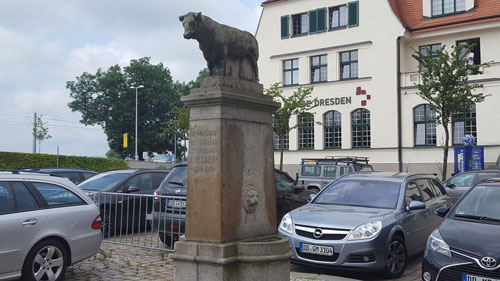
The cattle obelisk outside of the Messe Dresden. (Andrew Egan)
What it’s like to see Slaughterhouse-Five up close
We met at 9 am in the Theaterplatz and marvelled at the lack of people. Danilo suggested we walk as it would be faster than public transport. The weather was nice and the walk easy. We arrived in just under thirty minutes. If you know what to look for, the buildings quickly betray their history. In the front, a statue of a bull sits on an obelisk. Decorative, plaster mouldings of cattle flourish the outside walls.
Danilo left me to stare at the details while he approached the still operational guard station. For anyone looking to visit on their own, these details are about as much as you can see. Access to the interior of the slaughterhouse is granted on a case by case basis. It’s up to the guards whether or not to allow visitors inside, which put Danilo’s sudden personality change into context. He walked up to the guard station, one of the few structures to retain its original purpose, and broke into a sing-song version of German I hadn’t heard before. Though not a speaker of the language myself, it was the same cadence used by salesmen and anyone asking a favor. After a minute or so, he revealed a small pack of what looked like blue and white trading cards and gave a few of them to the guard. A few more pleasantries were exchanged and we were admitted to the grounds.
We arrived, at last. The actual Slaughterhouse-Five. A simple blue sign marks its entrance. The picture of me in front of it, helpfully taken by Danilo, is now in a place of prominence on my Facebook profile. A small tin medallion with the inscription "ORT 63", part of a collection placed around the city by a local historical society, is embedded in a curb in front. The medallion marks the survival of Vonnegut and his fellow POWs during the bombing.
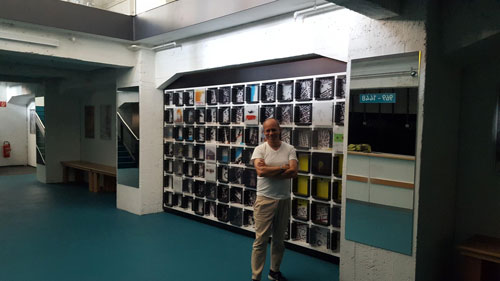
My tour guide, Danilo Hommel, standing in front of an art installation by Ruairí O’Brien. (Andrew Egan)
Like most buildings in Dresden, the inside of Slaughterhouse-Five has been heavily renovated. Today the buildings pull double duty as the city’s convention center and a sports academy. Had Vonnegut visited in 2016, he might have recognized the surroundings. Some elements of the original complex still remain.
The area that housed Vonnegut and the others is below ground at the end of a couple of flights of stairs. Once inside, the room kind of underwhelms. It has the smell of a newly constructed school but no immediately identifiable purpose. When I asked Danilo what the room is currently being used for, he replied with a chuckle, "It’s a coatroom."
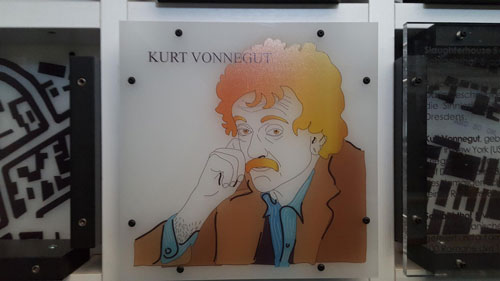
Close up of the Vonnegut panel. (Andrew Egan)
A few steps deeper inside this massive coatroom, on a section of wall opposite the check-in counter, is the only tribute to Vonnegut in the entire city. An art installation of hand painted glass and silk screened wood panels with scenes and quotes from the novel. Created by Irish artist Ruairí O’Brien, the work debuted in 2013 before a small crowd of local dignitaries and many more international supporters. Its illustrations are whimsical with vibrant colors that evoke a similar stylistic poignancy as the book.
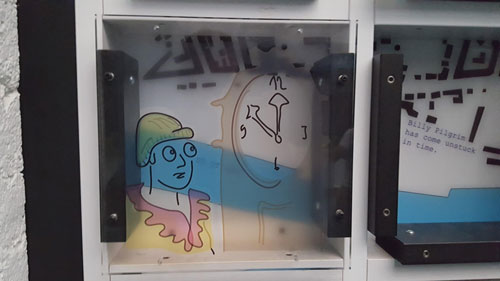
A Billy Pilgrim panel. (Andrew Egan)
After leaving the room, Danilo and I walked the grounds for a few more minutes before beginning the walk back to the Theaterplatz. The conversation had tapered, either because Danilo had run out of talking points or because he was used to leaving people with their thoughts after the experience. Our walk back seemed to take less time than before, even though our pace was much slower.
Danilo said that he takes a hundreds of people on the Vonnegut tour of Slaughterhouse-Five but it’s not his only source of income. He also offers tours of the city’s street art and historical buildings. The Vonnegut tour wouldn’t be enough for him to live on, he explains, because he can only take groups of twelve at most. He guesses that authorities don’t want to disrupt operations for the academy or convention center but punctuates his estimation with an exaggerated shrug. Tour groups are sometimes denied access, he adds.
That Vonnegut’s sanctuary is now just a coatroom is something the author would probably have found funny. Notoriously self-deprecating, he would also probably agree that his own history is relatively minor compared to the history surrounding the slaughterhouse. Though he might not have cared too much either way. When revisiting Dresden in the 1960s, Vonnegut was apparently taken to the wrong location and didn’t notice until some years after. So it goes.
Europe is crammed with history and granting public access to every significant site is impossible.
The Polish government recently asked for help from European nations and the U.S. to preserve Auschwitz. Germany has agreed to provide roughly half of the $170 million needed for restoration. Will the same treatment be afforded to lesser known, but equally important, sites as future generations create their own history? Whether embracing revenue or responsibility, communities across the continent have to carefully balance a host of variables when determining what to promote or avoid.
So if you miss something on your next trip, try to understand and consider the alternative. At least this way, we avoid ads for Auschwitz.
Andrew Egan is a writer based in Texas. His work has previously appeared in Forbes, ABC News, Tedium, and Atlas Obscura. You can visit his terrible website at CrimesinProgress.com or buy his even worse novel, Nothing Too Original.

